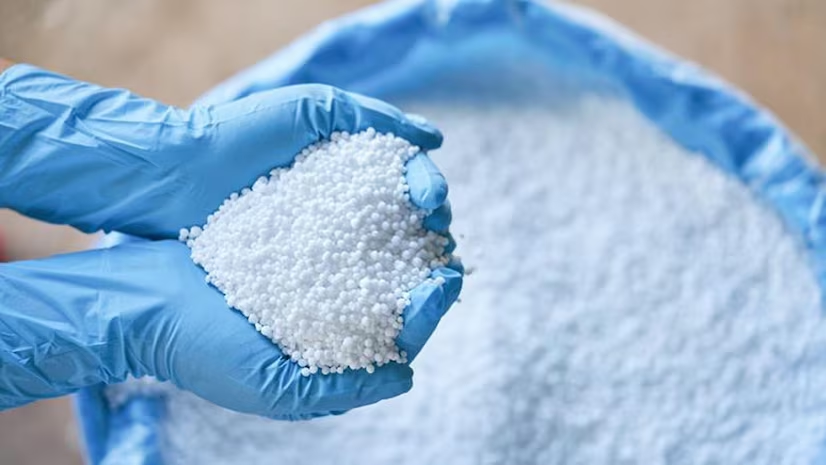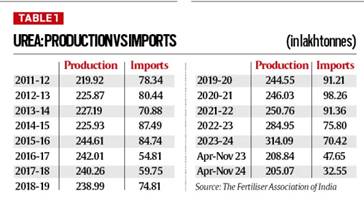- Courses
- GS Full Course 1 Year
- GS Full Course 2 Year
- GS Full Course 3 Year
- GS Full Course Till Selection
- Answer Alpha: Mains 2025 Mentorship
- MEP (Mains Enrichment Programme) Data, Facts
- Essay Target – 150+ Marks
- Online Program
- GS Recorded Course
- Polity
- Geography
- Economy
- Ancient, Medieval and Art & Culture AMAC
- Modern India, Post Independence & World History
- Environment
- Governance
- Science & Technology
- International Relations and Internal Security
- Disaster Management
- Ethics
- NCERT Current Affairs
- Indian Society and Social Issue
- NCERT- Science and Technology
- NCERT - Geography
- NCERT - Ancient History
- NCERT- World History
- NCERT Modern History
- CSAT
- 5 LAYERED ARJUNA Mentorship
- Public Administration Optional
- ABOUT US
- OUR TOPPERS
- TEST SERIES
- FREE STUDY MATERIAL
- VIDEOS
- CONTACT US
New Brownfield Ammonia-Urea Complex at Namrup IV
New Brownfield Ammonia-Urea Complex at Namrup IV

- The Union Cabinet, chaired by Prime Minister Narendra Modi has approved the setting up of a Brownfield Ammonia-Urea Complex (Namrup-IV) at Brahmaputra Valley Fertilizer Corporation Limited (BVFCL) in Namrup, Assam.
- The new complex will have an annual Urea production capacity of 12.7 Lakh Metric Tonnes (LMT).
- Project Cost and Financing:
- Total project cost: ₹10,601.40 Crore.
- The financing structure follows a Debt-Equity Ratio of 70:30 as per the New Investment Policy, 2012 (with amendments from 2014).
- Equity Participation:
- The equity pattern in the Joint Venture (JV) will be as follows:
- Government of Assam: 40%
- BVFCL: 11%
- Hindustan Urvarak & Rasayan Limited (HURL): 13%
- National Fertilizers Limited (NFL): 18%
- Oil India Limited (OIL): 18%
- The equity pattern in the Joint Venture (JV) will be as follows:
- Project Benefits:
- The project will increase domestic Urea production, catering especially to the North-Eastern region, and states like Bihar, West Bengal, Eastern Uttar Pradesh, and Jharkhand.
- It will contribute to energy-efficient Urea production, improving sustainability.
- The establishment of this complex will generate direct and indirect employment opportunities.
- Strategic Importance:
- The Namrup-IV project is aligned with India’s vision of achieving self-reliance in Urea production, reducing dependence on imports, and ensuring food security.

- The Namrup-IV project is aligned with India’s vision of achieving self-reliance in Urea production, reducing dependence on imports, and ensuring food security.
What are Brownfield and Greenfield projects ?
|
Aspect |
Brownfield |
Greenfield |
|
Definition |
Redevelopment of previously used land (industrial/commercial). |
Development on completely undeveloped land. |
|
Land Availability |
Land is often already owned or developed. |
Requires new land acquisition. |
|
Infrastructure |
Existing infrastructure (roads, utilities) may be available. |
No existing infrastructure; everything must be built from scratch. |
|
Cost |
Lower land acquisition costs, but may need remediation. |
Higher land and development costs. |
|
Environmental Impact |
May require cleanup of contamination or pollution. |
Minimal environmental concerns at the start. |
|
Development Speed |
Faster due to existing infrastructure. |
Slower due to need for infrastructure development. |
|
Sustainability |
Reusing land reduces urban sprawl and promotes sustainability. |
Potentially increases urban sprawl. |
Fertilizer Sector in India
- Agricultural Sector and Fertilizer Importance:
- Agriculture provides livelihood to 42.3% of India's population and contributes 18.2% to the country’s GDP (2023-24).
- Fertilizers, along with water and seeds, are crucial inputs for boosting agricultural productivity in India.
- 2025 Budget Allocation for Fertilizer : Rs. 118,860 crore for urea subsidy, Rs. 49,000 crore for P&K fertilizers.
- Increase in Fertilizer Production:
- Fertilizer production in India has increased significantly from 385.39 million tonnes (mt) in 2014-15 to 503.35 mt in 2023-24.
- Promotion of sustainable fertilizers like Nano Urea, Nano DAP, and organic fertilizers is also a key focus.
|
What is Liquid Nano Urea (LNU)?
|
- What is Urea Fertilizer:
- Urea is a nitrogen-rich fertilizer (46% nitrogen) used for crop growth.
- It is low-cost, with high nitrogen content making it economical in terms of transportation and storage.
- Urea has diverse applications, including:
- Cattle feed supplement
- Industrial use (e.g., in plastic production)
- Soil conversion to ammonia and carbon dioxide for plant absorption.\
Urea vs DAP (Di-Ammonium Phosphate) fertilizers ?
- Urea is primarily a nitrogen fertilizer that promotes vegetative growth, while DAP is a phosphorus-rich fertilizer essential for root development and overall plant health.
|
Aspect |
Urea |
DAP (Di-Ammonium Phosphate) |
|
Main Nutrient |
Nitrogen (46%) |
Phosphorus (18%) and Nitrogen (20%) |
|
Use |
Primarily for providing nitrogen to plants. |
Provides phosphorus for root development and overall plant growth. |
|
Application |
Often applied during the growing season to promote leaf and stem growth. |
Applied before or during sowing for root development and early growth. |
|
Color |
White |
Granular, typically off-white to pale yellow. |
|
Effect on Plants |
Stimulates vegetative (leaf and stem) growth. |
Stimulates root growth and helps flowering/fruiting. |
|
Cost |
Relatively cheaper compared to DAP. |
More expensive than urea due to higher phosphorus content. |
|
Environmental Impact |
High nitrogen content may lead to nitrogen leaching and environmental pollution. |
Can contribute to nutrient imbalances if not used correctly. |
|
Type |
Granular or liquid form. |
Granular form. |
- Rising Domestic Urea Production:

-
- Domestic urea production rose from 22 mt in 2011-12 to 31.4 mt in 2023-24.
- Imports have decreased from 7.8 mt to 7 mt, with a potential further drop below 5 mt, the lowest since 2006-07.
- The current fiscal shows a 31.7% reduction in imports.
- Greenfield Projects and Efficiency:
- 6 new urea plants have significantly increased production, contributing 7.55 mt in 2023-24, with investments ranging between ₹6,000 crore to ₹8,600 crore per plant.
- Notable plants include:
- HURL
- Chambal Fertilisers
- Matix Fertilisers
- RFCL
- Energy efficiency in new plants:
- New plants consume around 5 GCal per tonne of urea, compared to 5.5-6.5 GCal for older units.
- The Matix Fertilizer plant in Panagarh (West Bengal) is the most energy-efficient with 4.856 GCal/tonne.
- Regional Focus:
- New plants serve the “New Green Revolution” regions (e.g., Eastern UP, Bihar, West Bengal, Jharkhand, Telangana), catering to 20% of the market in Eastern India.
- Older units (e.g., NFL’s Bathinda, Nangal, Panipat) primarily cater to Punjab and Haryana.
- Make vs. Buy Debate:
- Domestic production costs: $427-$493 per tonne.
- Imported urea costs: $370-$403 per tonne.
- Logistical advantages: Domestic plants reduce transportation and bagging costs, making them more viable for Northern and Eastern India.
- Make-in-India initiative: Domestic production supports employment and economic activity.
- Strategic Shift and Policy Recommendations:
- Regional production strategy: Focus on enhancing production in Northern and Eastern India, while optimizing imports for Peninsular India.
- Shut down inefficient plants to improve energy efficiency.
- Rational pricing: The farmgate price of urea has been fixed at ₹5,360/tonne since 2012, leading to excessive consumption. Rationalizing the pricing could:
- Promote balanced fertilizer use.
- Reduce dependency on imports and domestic production.
What is Need for Self-Sufficiency in Urea:
- India's dependency on urea imports: India has been importing urea for decades to meet the shortfall in domestic production.
- India is the world's largest importer of urea, which affects global urea prices due to its large demand.
- Along with urea, India is also the largest buyer of Di-Ammonium Phosphate (DAP), the second most commonly used fertilizer in India after urea.
- Urea and DAP prices: Both fertilizers saw a sharp rise in global prices in 2022, mainly due to supply disruptions, which significantly impacted Indian farmers.
- Agricultural dependence: Since nearly 70% of India's population relies on agriculture, any disruption in fertilizer supply or price increases has a direct adverse impact on the rural economy.
- The demand for urea is expected to remain high in the future, and continued reliance on imports is not a sustainable solution.
What are the Steps Toward Self-Sufficiency:
- To reduce dependency on imports, the government has taken steps such as the establishment of several brownfield urea plants in the public sector since 2016.
- Self-sufficiency in urea could save the government nearly ₹40,000 crore annually, which would be a major economic benefit.
Government Initiatives in the Fertilizer Sector
- Nano Urea Production:
- 8 new Nano Urea plants will begin production by November 2025.
- These plants will be located in various states such as Karnataka, Uttar Pradesh, and Assam.
- The production of Nano Urea is aimed at enhancing efficiency in nitrogen use, reducing dependency on conventional urea, and promoting sustainable farming practices.
- Neem Coating of Urea:
- The Department of Fertilizers (DoF) has made it mandatory for all domestic producers to produce 100% Neem Coated Urea (NCU).
- Benefits of Neem Coating:
- Improves soil health
- Reduces the usage of plant protection chemicals.
- Helps in the slow-release of nitrogen, preventing leaching and increasing urea efficiency.
- New Urea Policy (NUP) 2015:
- Key objectives of the policy:
- Maximize indigenous urea production to reduce dependency on imports.
- Promote energy efficiency in urea units to enhance sustainability.
- Rationalize subsidy burden on the government, ensuring efficient allocation of resources.
- Key objectives of the policy:
- New Investment Policy (NIP) 2012:
- Introduced to facilitate fresh investment in the urea sector and make India self-sufficient in urea production.
- Amended in 2014 to incentivize investment and improve the domestic urea manufacturing capacity.
- Policy on Promotion of City Compost:
- City Compost Policy was approved by the Government of India in 2016.
- It provides Market Development Assistance of ₹1500 to boost the production and consumption of city compost, a sustainable alternative to chemical fertilizers.
- Aims to promote waste-to-fertilizer solutions and improve soil health.
- Use of Space Technology in Fertilizer Sector:
- The Department of Fertilizers commissioned a three-year pilot study on "Resource Mapping of Rock Phosphate".
- This study, conducted by National Remote Sensing Centre (NRSC) under ISRO, in collaboration with Geological Survey of India (GSI) and Atomic Mineral Directorate (AMD), uses space technology and Earth Observation data for better resource mapping and sustainable use of phosphate resources.
- Nutrient Based Subsidy (NBS) Scheme:
- Implemented in April 2010 by the Ministry of Chemicals and Fertilizers.
- Under this scheme, a fixed amount of subsidy is provided annually for each grade of Phosphatic & Potassic (P&K) fertilizers, based on their nutrient content.
- The aim is to encourage the use of fertilizers based on their nutrient content rather than just their weight, ensuring better nutrient management and efficiency.
|
Also Read |
|
| NCERT Books For UPSC | |
| UPSC Monthly Magazine | Best IAS Coaching in Delhi |




